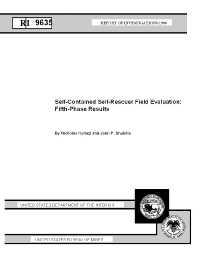Mining Publication: Self-Contained Self-Rescuer Field Evaluation: Fifth-Phase Results
Original creation date: January 1996
A joint effort by the Pittsburgh Research Center (PRC) and the Mine Safety and Health Administration (MSHA) was undertaken to determine how well self-contained self-rescuers (SCSR's), deployed in accordance with Federal regulations (30 CFR 75.1714), held up in the underground environment with regard to both physical damage and aging. This report presents findings regarding laboratory-tested SCSR's in the fifth phase of testing from mid -1993 to early 1996. The SCSR's were tested on human subjects and on a breathing and metabolic simulator (BMS) at PRC. These results indicate that most of the apparatus, if they pass their inspection criteria, perform satisfactorily.
Authors: N Kyriazi, JP Shubilla
Report of Investigations - January 1996
NIOSHTIC2 Number: 20000773
Pittsburgh, PA: U.S. Department of Energy, Report of Investigations 9635. NTIS stock number: PB97-124937, 1996; :1-22
See Also
- How to Operate a Refuge Chamber: A Quick Start Guide
- I Can't Get Enough Air! Proper Self-contained Self-rescuer Usage
- Probability of Making a Successful Mine Escape While Wearing a Self-Contained Self-Rescuer
- Refuge Chamber Expectations Training - 1.0
- Self-Contained Self-Rescuer Field Evaluation: First-Year Results of 5-Year Study
- Self-Contained Self-Rescuer Field Evaluation: Fourth-Phase Results
- Self-Contained Self-Rescuer Field Evaluation: Results From 1982-90
- Self-Contained Self-Rescuer Field Evaluation: Seventh-Phase Results
- Self-Contained Self-Rescuer Field Evaluation: Sixth-Phase Results
- Self-Contained Self-Rescuer Long Term Field Evaluation Tenth Phase Results
- Content source: National Institute for Occupational Safety and Health, Mining Program


 ShareCompartir
ShareCompartir
